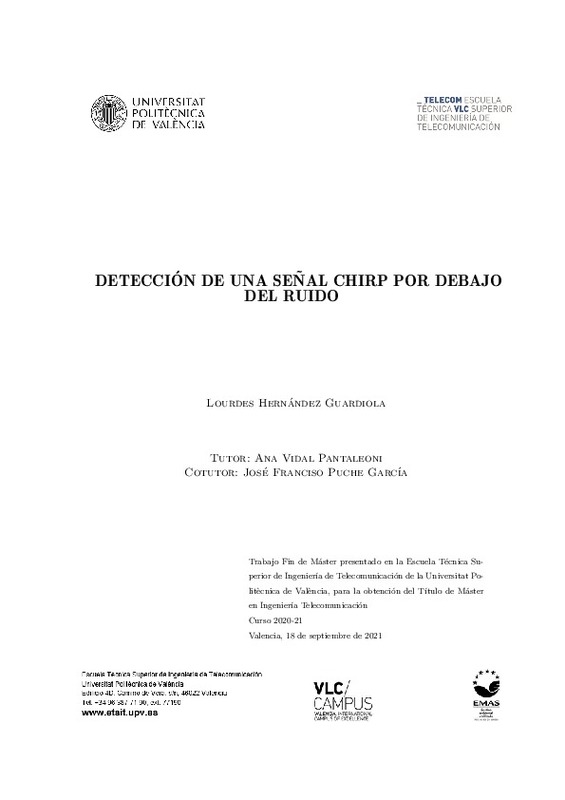JavaScript is disabled for your browser. Some features of this site may not work without it.
Buscar en RiuNet
Listar
Mi cuenta
Estadísticas
Ayuda RiuNet
Admin. UPV
Detección de una señal Chirp por debajo del ruido
Mostrar el registro sencillo del ítem
Ficheros en el ítem
| dc.contributor.advisor | Vidal Pantaleoni, Ana
|
es_ES |
| dc.contributor.advisor | Puche García, José Francisco
|
es_ES |
| dc.contributor.author | Hernández Guardiola, Lourdes
|
es_ES |
| dc.date.accessioned | 2021-10-05T10:12:33Z | |
| dc.date.available | 2021-10-05T10:12:33Z | |
| dc.date.created | 2021-09-28 | |
| dc.date.issued | 2021-10-05 | es_ES |
| dc.identifier.uri | http://hdl.handle.net/10251/173833 | |
| dc.description.abstract | [ES] En este Trabajo Fin de Máster (TFM) se han realizado una serie de simulaciones con el objetivo de estimar la sensibilidad de un filtro adaptado a la señal Chirp. Tras efectuar un estudio acerca del estado del arte sobre la estimación de señales LPI (Low Probability Interception), se determinó que los métodos que ofrecen mejores resultados son las redes neuronales y los bancos de filtros adaptados. Dado que las redes neuronales presentan una mayor complejidad respecto a su arquitectura (las cuales requieren de varias capas para alcanzar mejores resultados) y a la necesidad de entrenarlas, se decidió optar por un análisis previo empleando filtros adaptados. Con objeto de establecer la señal a utilizar en las simulaciones se llevó a cabo un profundo estudio sobre el sistema RADAR, analizando las señales que usa para transmitir. Dicho estudio determinó que la señal más adecuada para ello debía ser la señal Chirp, dado que es la más empleada por los sistemas radares debido a que es una señal resistente frente a interferencias. Tras programar el código correspondiente para generar la señal y su filtro adaptado, se ejecutaron una serie de simulaciones con las que se estimaron los límites de la frecuencia central de la señal en el que el filtro es capaz de detectarla, el límite inferior de tasa que debe tener y el nivel mínimo de SNR detectable, con el propósito de conseguir una probabilidad de detección del 80% y una probabilidad de falsa alarma del 20 %. | es_ES |
| dc.description.abstract | [EN] In this Master¿s Dissertation, a series of simulations have been carried out in order to estimate the sensitivity of a matched filter to the Chirp signal. After carrying out a study on the state of the art on the estimation of LPI signals (Low Probability Interception), it was determined that the methods that offer the best results are neural networks and matched filter banks. Given that neural networks present greater complexity with respect to their architecture (which require several layers to achieve better results) and the need to train them, it was decided to opt for a prior analysis using matched filters. To establish the signal to be used in the simulations, an in-depth study was carried out on the RADAR system, analysing the signals it uses to transmit. This study determined that the most suitable signal for this should be the Chirp signal since it is the most used by radar systems because it is a signal resistant to interference. After programming the corresponding code to generate the signal and its matched filter, a series of simulations were run that estimated the limits of the central frequency of the signal in which the filter can detect it, the lower rate limit that must have and the minimum detectable SNR level, in order to achieve a detection probability of 80% and a false alarm probability of 20 %. | es_ES |
| dc.format.extent | 68 | es_ES |
| dc.language | Español | es_ES |
| dc.publisher | Universitat Politècnica de València | es_ES |
| dc.rights | Reconocimiento - No comercial - Sin obra derivada (by-nc-nd) | es_ES |
| dc.subject | Chirp | es_ES |
| dc.subject | Filtro adaptado | es_ES |
| dc.subject | Frecuencia central | es_ES |
| dc.subject | Rate | es_ES |
| dc.subject | PRI | es_ES |
| dc.subject | PW | es_ES |
| dc.subject | Pulsos | es_ES |
| dc.subject | Matched filter | es_ES |
| dc.subject | Central frequency | es_ES |
| dc.subject | Pulses | es_ES |
| dc.subject.classification | TEORIA DE LA SEÑAL Y COMUNICACIONES | es_ES |
| dc.subject.other | Máster Universitario en Ingeniería de Telecomunicación-Màster Universitari en Enginyeria de Telecomunicació | es_ES |
| dc.title | Detección de una señal Chirp por debajo del ruido | es_ES |
| dc.type | Tesis de máster | es_ES |
| dc.rights.accessRights | Abierto | es_ES |
| dc.contributor.affiliation | Universitat Politècnica de València. Departamento de Comunicaciones - Departament de Comunicacions | es_ES |
| dc.contributor.affiliation | Universitat Politècnica de València. Escuela Técnica Superior de Ingenieros de Telecomunicación - Escola Tècnica Superior d'Enginyers de Telecomunicació | es_ES |
| dc.description.bibliographicCitation | Hernández Guardiola, L. (2021). Detección de una señal Chirp por debajo del ruido. Universitat Politècnica de València. http://hdl.handle.net/10251/173833 | es_ES |
| dc.description.accrualMethod | TFGM | es_ES |
| dc.relation.pasarela | TFGM\145055 | es_ES |
Este ítem aparece en la(s) siguiente(s) colección(ones)
-
ETSIT - Trabajos académicos [2408]
Escuela Técnica Superior de Ingenieros de Telecomunicación






